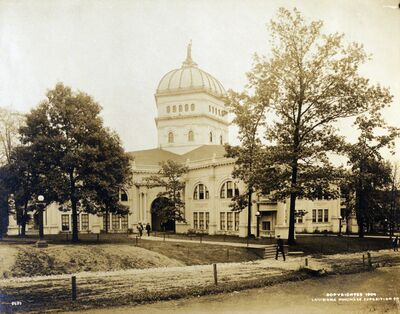Texas
 | |
| Location | The Trail |
|---|---|
| Construction | |
| Construction Cost | $45,562 ($1.37 million in 2021) |
| Furnishing Cost | $12,000 ($361,911 in 2021) |
| Dates | |
| Dedication Day | May 4, 1904 |
| Architecture | |
| Architect | Chas. H. Page, Jr., of Austin |
| Dimensions | 234' tip to tip |
Texas' 'Lone Star' State building was a huge five-pointed star-shaped edifice, surmounted by a squared dome, located on the Plateau of States.
Description
striking in the originality and boldness of architectural conception, is the five-pointed star building of Texas. Pinning the points together is a great dome, 132' from the ground. Crowning the dome, around which is an inviting promenade, is a large statue of the Goddess of Liberty holding aloft a five pointed star.
At the end of the five points are two columns, indicative of industries and supporting statues of Texas heroes. There are, of course, ten walls. At the base, where every pair of walls meet, is an entrance.
Inside, at the center beneath the dome, is a hexagon-shaped assembly room where a miniature of the famous Alamo fountain at San Antonio is located, surrounded by a basin containing specimens of all the water plants peculiar to the Lone Star state.
Branching from this main rotunda are 5 wedge shaped areas. Each of the star points contains two stories, the upper ones being used for private apartments. All the rooms on the second floor are finished in native woods and marbles of Texas.
One of the handsomest small decorated rooms is the parlor with its delicate light green colorings, its hand-painted draperies and curtains of shimmering silk.
The Woman's Clubs of Texas had the point next to it, with ivory woodwork and mission furniture. Here a Conover upright is placed, and also busts of great and famed Texans in bronze. In the entrance to the ladies' parlor is a statue — "The Galveston Flood." It shows a mother clasping to her breast the form of her dead baby, while another child clings to her. Done in the purest of white marble, it could hardly be more striking.
In one point is the art and sculpture room, with a great statue of the Rev. Dr. Rufus Burleson, founder of a large Texas university, and of King Ludwig III of Bavaria, by Elizabeth Ney.
The next point is the historical room with portraits of men and women famed in the Texas revolution, century-old bells from the Spanish missions, arms and swords of the revolution period, rough-hewn crosses and holy pictures taken from ancient monasteries.
The other point contained the offices, furnished in curly pine.
